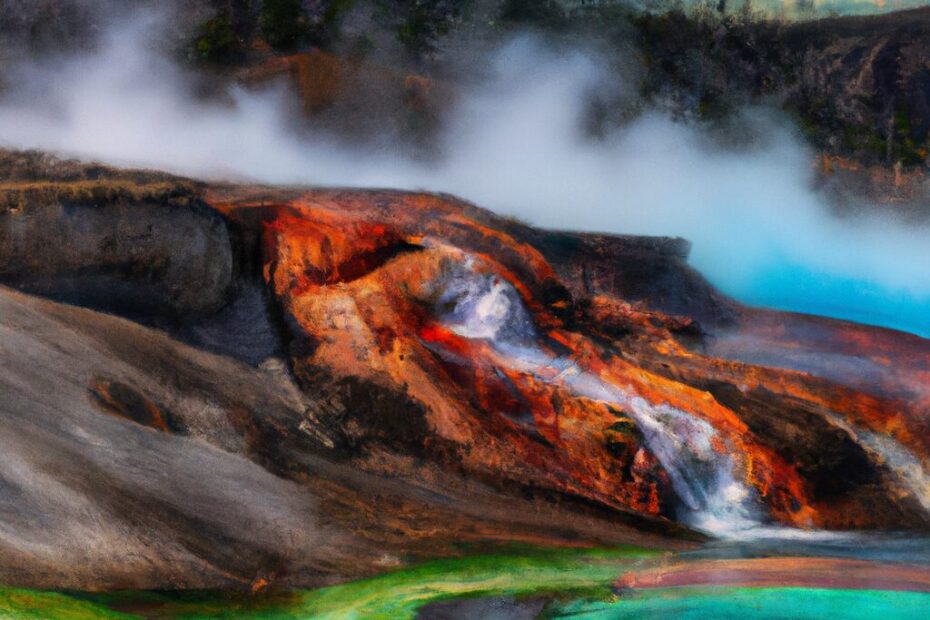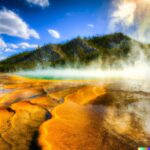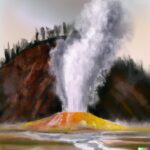Have you ever wondered about the fascinating world of geysers? In this article, we will take a closer look at the renowned Grand Geyser Basin in Yellowstone National Park. From the impressive Grand Geyser to the colorful thermal features, this area is a must-visit for any nature lover.
Discover the unique characteristics that make the Grand Geyser Basin stand out, and learn about the various ways you can explore this captivating destination. Join us on a journey to uncover the beauty and wonder of these natural wonders.
What Are Geysers?
Geysers are natural hydrothermal features found in various locations around the world, with Yellowstone National Park being one of the most famous destinations known for its spectacular geysers, hot springs, and unique geological formations.
These remarkable formations are created when underground water is heated by magma, causing it to erupt in a powerful column of steam and water. The thermal activity beneath the Earth’s surface plays a crucial role in the development of geysers, with the geothermal energy generating the pressure needed for these impressive displays.
Yellowstone National Park boasts an extraordinary collection of geysers, including the iconic Old Faithful, renowned for its predictably regular eruptions that draw in spectators from all over the world. The park’s geysers showcase a diverse range of sizes, shapes, and eruption patterns, making each one a unique spectacle to behold.
Where Is Yellowstone National Park?
Yellowstone National Park, located primarily in the U.S. states of Wyoming, Montana, and Idaho, is renowned for its stunning natural beauty, diverse ecosystems, and iconic geothermal features, making it a top tourist destination and a must-visit for nature enthusiasts.
Nestled in the heart of the Rocky Mountains, Yellowstone National Park spans over 2.2 million acres, encompassing a vast wilderness that showcases rugged canyons, lush forests, alpine rivers, and dramatic waterfalls. The park’s geothermal wonders, including the world-famous Old Faithful geyser and the vibrant Grand Prismatic Spring, offer visitors a glimpse into the powerful forces of the Earth. Yellowstone’s wildlife, such as grizzly bears, wolves, elk, and bison, roam freely across its landscapes, providing unique and thrilling encounters for visitors seeking to observe these majestic creatures in their natural habitat.
What Is the Grand Geyser Basin?
The Grand Geyser Basin, part of the larger Norris Geyser Basin in Yellowstone National Park, is home to mesmerizing geothermal features, including the famous Excelsior Geyser and Morning Glory Pool, characterized by vibrant colors, bubbling pools, and unique geological formations.
Visitors to the Grand Geyser Basin are struck by the awe-inspiring variety of colors that paint the landscape, ranging from vivid blues and greens to deep oranges and yellows, created by the diverse mineral deposits in the hydrothermal pools.
The Excelsior Geyser, with its massive eruptions and steam columns that can rise up to 300 feet in the air, captivates onlookers with its raw power and beauty.
The Morning Glory Pool, a stunning hot spring, exhibits a kaleidoscope of colors, drawing in spectators with its ever-changing hues that shift with the temperature variations.
Walking through this basin is like stepping into a geological wonderland, where the Earth’s inner workings are on full display.
Which Geysers Are Found in the Grand Geyser Basin?
The Grand Geyser Basin boasts a collection of remarkable geysers, including the renowned Grand Geyser, Castle Geyser, Riverside Geyser, Grotto Geyser, and Daisy Geyser, each showcasing the power of boiling water and captivating hydrothermal features.
Grand Geyser, the namesake of the basin, is famous for its majestic eruptions that can soar up to 200 feet in the air, making it one of the tallest predictable geysers in the world. Its eruptions can last for up to 12 minutes, creating a mesmerizing sight for onlookers.
Castle Geyser, characterized by its distinctive cone shape, erupts in a series of powerful bursts, while Riverside Geyser offers a stunning show as it releases boiling water right beside the Firehole River.
Grotto Geyser impresses with its crystal-clear pool and sporadic eruptions, and Daisy Geyser captivates visitors with its predictably frequent but lower-height eruptions surrounded by delicate formations.
What Makes the Grand Geyser Basin Unique?
The Grand Geyser Basin stands out as the largest geyser basin in Yellowstone National Park, renowned for its colorful thermal features, active geysers, and bubbling hot springs that create a truly spectacular sight for visitors.
Visitors to the Grand Geyser Basin are greeted by a symphony of bubbling pools, hissing steam, and the occasional explosive eruption of the geysers, adding an element of unpredictability and excitement to the experience. The vibrant hues of the thermal pools, ranging from deep blues to vivid oranges and greens, are a mesmerizing contrast against the stark landscape, offering a visual feast for the eyes. As tourists wander the boardwalks weaving through the basin, they can witness the steadfast power of nature in action, with geysers like Old Faithful punctuating the landscape with dramatic shows of boiling water and steam.
How Can You Visit the Grand Geyser Basin?
Exploring the Grand Geyser Basin can be done through various means, including by car, hiking trails, or opting for a guided tour, offering visitors a chance to witness firsthand the geological wonders and tourist attractions of this remarkable hotspot.
- Traveling by car is ideal for those who prefer a flexible schedule, allowing for easy transportation to the basin’s entrance.
- Hiking along the designated trails provides a more immersive experience, with opportunities to observe unique flora and fauna along the way.
- For visitors seeking a guided educational experience, joining a tour led by knowledgeable experts can offer insights into the geological significance and historical context of the Grand Geyser Basin.
What Are the Geysers’ Eruption Patterns?
Understanding the eruption patterns of geysers involves analyzing their eruptive behavior, phases of eruption, predictive patterns, and the science behind forecasting geyser eruptions based on historical data and geothermal activity.
During eruptions, geysers showcase distinct behaviors such as the initial pressure buildup before the release of a powerful water and steam column. The eruption cycle typically consists of an eruption phase, followed by a period of quiet and recharge. Geysers exhibit various patterns in terms of eruption frequency, duration, and intensity, which are crucial for studying their natural rhythms. Geologists and researchers use a combination of seismographs, temperature sensors, and water level monitoring to predict when the next eruption might occur and the overall patterns that govern geyser activity.
How Do Geysers Form?
The formation of geysers is a result of complex geological processes involving a heat source, underground geothermal reservoirs, the movement of magma beneath the Earth’s crust, and the build-up of pressure that eventually leads to the iconic eruption of superheated water and steam.
This spectacular natural phenomenon occurs when water seeps deep into the Earth’s crust, where it comes into contact with hot rocks and magma. The heat from the Earth’s interior warms the water, turning it into a high-pressure mixture. As the water continues to be heated and pressure builds up, it seeks pathways to escape, resulting in the explosive release of steam and water through vents in the ground, creating the awe-inspiring spectacle of a geyser eruption.
What Are the Environmental Impacts of Geothermal Activity?
The environmental impacts of geothermal activity encompass a range of factors, including changes in hydrology, potential bacterial growth in hydrothermal systems, alterations in environmental conditions, and the overall ecological effects of sustained geothermal activity on local ecosystems.
These changes in hydrology can lead to shifts in water availability and the redistribution of nutrients in the affected areas. Bacterial growth in hydrothermal systems can introduce new microorganisms to these ecosystems, potentially disrupting the existing balance. The alterations in environmental conditions due to geothermal processes can impact vegetation patterns and wildlife habitats, influencing biodiversity.
When considering the broader ecological implications of geothermal energy on ecosystems, it becomes evident that careful monitoring and management are essential to mitigate any negative consequences on the environment.
What Are Hydrothermal Fluids and Their Significance?
Hydrothermal fluids play a crucial role in shaping geological formations, supporting unique ecosystems with diverse aquatic life, and carrying superheated water from beneath the Earth’s crust to the surface, showcasing the dynamic interplay between geology, biology, and geothermal processes.
These fluids are not only responsible for creating visually striking features such as hydrothermal vents, mineral deposits, and geysers but also play a vital role in providing essential nutrients for the growth of specialized organisms that thrive in these extreme environments.
The transportation of superheated water through hydrothermal systems helps regulate Earth’s heat balance and serves as a conduit for the circulation of minerals and chemicals crucial for various biological processes both above and below the surface.
Exploring Geothermal Features in Yellowstone National Park
Exploring the geothermal features in Yellowstone National Park offers a firsthand encounter with boiling point phenomena, steam vents releasing hotter water, and the captivating landscapes of a geological hotspot known for its unique hydrothermal displays.
As visitors journey deeper into the park, they are met with a spectacle of vibrant colors created by heat-loving bacteria thriving in the extreme conditions. Pockets of even hotter waters can be found in specific locations, such as the famous Grand Prismatic Spring, where the water temperature can exceed 180 degrees Fahrenheit. The hissing sound of steam vents and the Earth’s low rumblings add to the mystical atmosphere surrounding these natural wonders.
Grand Geyser
Grand Geyser, one of the notable features in the Grand Geyser Basin, showcases the power of active geysers connected to intricate hydrothermal systems beneath the surface of Yellowstone National Park.
Its eruptions, which can reach up to 200 feet in height, are not only impressive but also offer a glimpse into the dynamic nature of geothermal activity in the region. The Grand Geyser is known for its predictability, erupting approximately every 7 to 15 hours, making it a popular attraction for visitors eager to witness the spectacle. The interplay of pressure and temperature within the hydrothermal system contributes to the frequent and spectacular displays that have cemented the Grand Geyser’s reputation as one of the must-see wonders of Yellowstone.
Castle Geyser
Castle Geyser, with its distinctive cone structure, exhibits unique eruptive patterns driven by the heat convection processes occurring within its hydrothermal system, creating a mesmerizing spectacle for visitors.
As Castle Geyser’s eruptions occur, the rising hot water and steam mix with cooler water near the surface, triggering a cyclic process of pressure buildup leading to its explosive releases. This dynamic interplay of temperature differentials and pressure variations contributes to the geyser’s rhythmic eruptions that can reach impressive heights. The cone structure of Castle Geyser adds to its visual allure during these spectacular displays, with mineral deposits creating vibrant colors and textures on its surface, enhancing the overall experience for onlookers.
Riverside Geyser
Riverside Geyser, situated along the banks of a waterway, follows a distinct timing and cycle in its eruptions, providing an intriguing display of geyser activity that harmonizes with the surrounding aquatic environment.
Its eruptions, punctuated by a rhythmic cadence that almost seems orchestrated by nature itself, create a mesmerizing interplay with the flowing water of the adjacent river.
The cyclical nature of its eruptions adds to the anticipation, with spectators eagerly awaiting the next burst of steam and water that shoots into the sky. This dynamic interaction between the geyser’s eruptions and the river’s currents enhances the visual spectacle, offering a captivating blend of natural elements that showcase the beauty and power of geothermal activity.
Grotto Geyser
Grotto Geyser, nestled within a geothermal field, showcases varying durations in its eruptions, reflecting the dynamic nature of geyser activity within the broader context of the geothermal landscapes in Yellowstone National Park.
These fluctuations in eruption durations at Grotto Geyser are influenced not only by internal factors but also by the complex interplay with the surrounding geothermal features. The intricate underground network of hot springs, fumaroles, and other geysers in the vicinity contributes to the unique character of Grotto Geyser’s eruptions. This interaction with the broader geothermal field not only shapes the geyser’s behavior but also plays a significant role in the overall geothermal dynamics of the park, highlighting the interconnected nature of the geothermal system in Yellowstone.
Daisy Geyser
Daisy Geyser, known for its predictable eruptions resembling a blooming flower, attracts geothermal tourists seeking engaging hot spring activities and the mesmerizing spectacle of nature’s hydrothermal wonders.
Visitors to Daisy Geyser are often captivated by the vibrant colors and unique formations created by the mineral-rich waters as they jet into the air. Surrounding the geyser, there are opportunities for guests to soak in natural hot springs, creating a tranquil and rejuvenating experience. Some adventurous tourists may also partake in activities like hiking along geothermal trails or capturing stunning photographs of the geyser’s eruptions against the picturesque backdrop of the Yellowstone National Park landscape.
Appreciating the Natural Beauty of Norris Geyser Basin
Norris Geyser Basin offers a glimpse into the raw beauty of nature with its geothermal spots, bubbling hydrothermal vents, and the underlying magma movements that shape the captivating landscape of this unique thermal area.
Visitors to Norris Geyser Basin can witness the mesmerizing activity of the hydrothermal vents, where boiling water and steam escape from the depths of the Earth, creating a surreal atmosphere. The geothermal features in the basin include colorful hot springs, bubbling mud pots, and erupting geysers, showcasing the dynamic forces at work beneath the surface. As magma moves deep underground, it heats water that then rises to the surface, playing a crucial role in maintaining the basin’s distinct thermal environment.
Steamboat Geyser
Steamboat Geyser, famous for its towering eruptions, is a subject of intense geothermal surveys that aim to understand the distinct phases of its eruptions, providing valuable insights into the geothermal activity prevalent in Yellowstone National Park.
The explosive nature of Steamboat Geyser’s eruptions has fascinated geologists and researchers for years, with its unpredictability adding an element of mystery. Scientists have been closely monitoring this geyser to capture data on the intervals between eruptions, the duration of each eruption, and the volume of water ejected.
These ongoing geothermal surveys help in unraveling the dynamics behind the geyser’s behavior, shedding light on the underground processes that lead to such powerful outbursts. The findings from studying Steamboat Geyser contribute significantly to advancing our understanding of geothermal systems within the park.”
Last Updated on February 8, 2024 by Jon Waraas – Originally Posted: February 7, 2024

I’m Jon Waraas, and I’ve been navigating the online world since 2006. By day, I’m the proud owner of some eCommerce gems, and by night, I’m the voice behind the adventures on Waraas.Com.
My heart, however, belongs to the wild beauty of Yellowstone National Park. I’ve got a collection of websites dedicated to sharing the wonders of this natural masterpiece. Oh, and did I mention? I’m currently building my own cabin inside the ghost town of Gilmore, Idaho – a cabin with tales to tell!
When I’m not immersed in the digital realm, you’ll find me lacing up my boots for a good hike or setting up camp under the star-studded sky.




